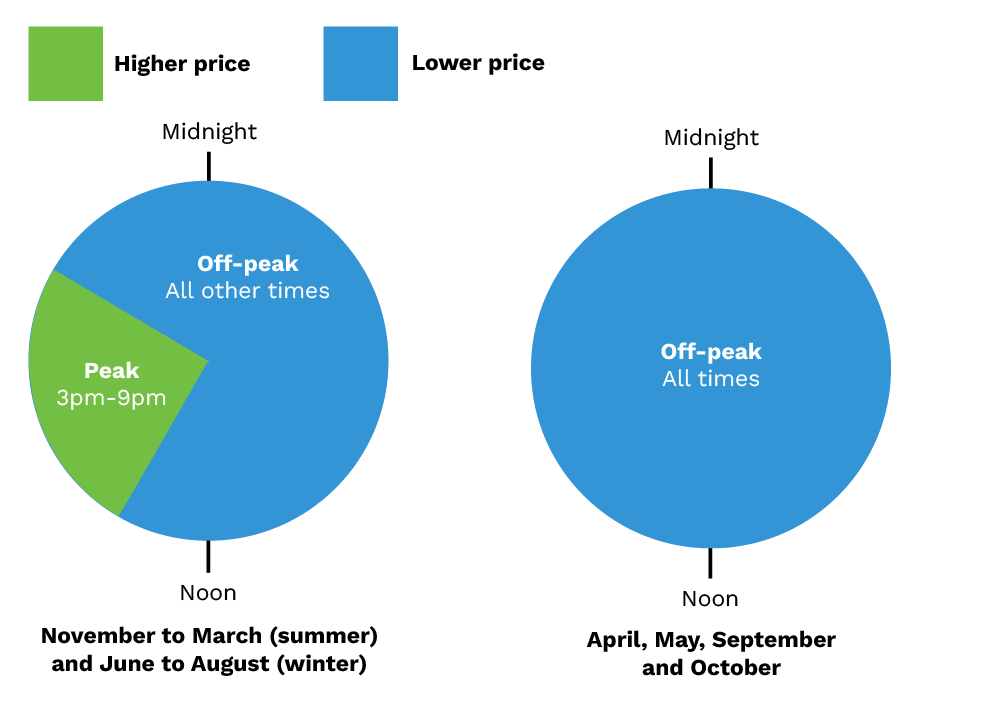Demand is how much, or how little, your household uses the electricity network (poles and wires) at a particular time. Demand is different from consumption, which is the total amount of electricity you use over a certain time.
Customers on a demand tariff or demand pricing plan will have a demand charge on their bill. A demand tariff includes a charge for using electricity at the busiest times, which typically start between mid-and late afternoon and end mid-evening. Customers can control their bills by choosing to use electricity outside the peak demand times.
Customers’ future electricity demand during the busiest times is the main driver of future costs for Australia’s electricity networks. These costs drive our network prices. With demand charging, you can benefit by lowering your electricity demand during the busiest times. You’ll pay no more than your share for the load you place on the network.
How do demand charges work?
A demand charge on your electricity bill is typically calculated on the level of your household’s demand on the electricity network (i.e. the poles and wires) during a specified time period or window.
Demand charges encourage you to use electricity more often outside of peak times. The lower your demand in those peak times, the less you pay for using the network. A monthly demand charge changes depending on your demand. With demand charging, you can benefit by lowering your electricity demand during the busiest times. You’ll pay no more than your share for the load you place on the network.
For residential customers: Ausgrid’s peak pricing window is every day between 3pm and 9pm all days in the June-August and November-March periods.
For small business customers: Ausgrid’s peak pricing window is Monday to Friday (working weekdays) between 3pm and 9pm all days in the June-August and November-March periods.

If you are on a demand pricing plan:
- Ask your retailer for the days and times their peak window applies.
- Ask your retailer how they calculate your demand charge. This will usually be the one day of the month when the highest 30-minute period of consumption occurs, during that day’s peak demand window, measured in kilowatts and multiplied by the number of days in that month.
Your energy retailer may show the demand charge on your electricity bill depending on the type of plan you choose.
Demand tariffs require smart meters
Demand tariffs are only available to customers who have a smart meter installed. If your meter has recently been upgraded to a smart meter you may have been put onto a demand tariff or demand pricing plan. If demand based usage does not suit your energy use, you can ask your energy retailer to be reassigned to another available tariff option, such as time-of-use pricing.
How will a demand tariff affect customers with solar panels?
Many customers with solar panels currently receive a feed-in tariff for energy they feed into the network. Solar customers will still receive a feed-in tariff from their retailer. For customers on a demand tariff, solar customer usage and demand will be charged in the same way as other customers on the tariff.
Those solar customers drawing on batteries for energy during the peak demand window can expect a minimal monthly demand charge. For solar customers using no electricity at all from the grid, they will continue only to pay the fixed daily supply charge on their bill. A metering service charge may also apply.
Customers and/or Energy Retailers can opt in to Ausgrid’s Export Tariff, which features a low charge for energy exported into the network between 10am and 3pm, and an export reward between 4pm and 9pm.
From 1 July 2026 all small customers who are export capable will be assigned to this export tariff. We expect this change will have a minimal impact on overall electricity costs for our solar exporting customers. Find out more about Solar Tariffs.
How to read your bill
To check whether your retailer has a demand pricing plan that uses Ausgrid’s demand network tariff check your bill.
A demand pricing plan will include:
Fixed daily supply charge
The cost per day to supply electricity to your premises.
Consumption charge
A variable charge based on the total amount of electricity you use.
Demand charge
A variable monthly charge based on your demand at peak times.




